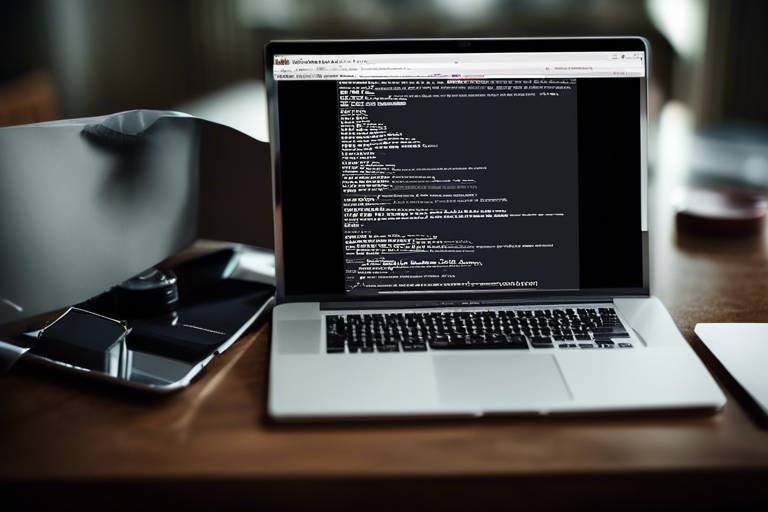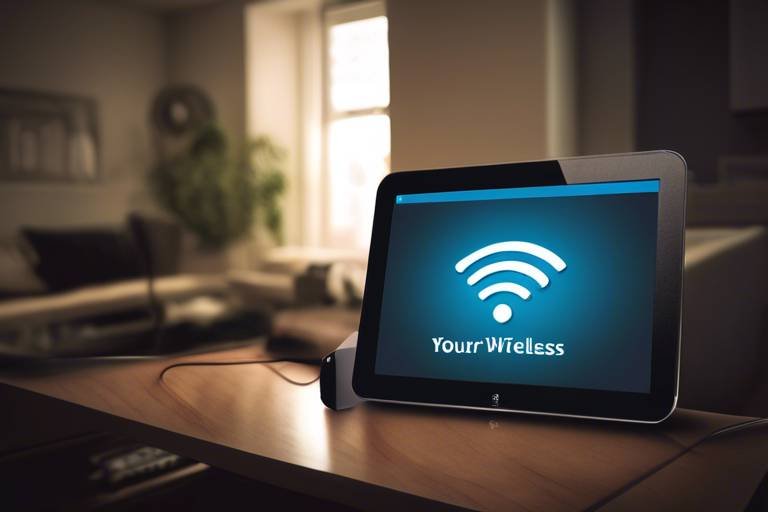How to Safeguard Your WiFi Network
In today's digital age, securing your WiFi network is more crucial than ever. Think of your WiFi as the gateway to your entire digital life; if it's compromised, everything from your personal emails to online banking can be at risk. So, how can you ensure that your network remains a fortress against unauthorized access and cyber threats? In this article, we will explore essential strategies and best practices that will not only protect your WiFi but also give you peace of mind.
First things first, let’s dive into the various WiFi security protocols. You might have heard of terms like WEP, WPA, and WPA2, but what do they really mean? These protocols are like the locks on your front door: some are stronger than others. WEP (Wired Equivalent Privacy) is outdated and can be easily breached. On the other hand, WPA (WiFi Protected Access) and its successor WPA2 offer stronger security features. They encrypt your data, making it much harder for hackers to intercept. If your router supports WPA2, you should definitely use it as your primary security protocol. Remember, a strong lock is your first line of defense!
Now that you understand the importance of security protocols, let’s move on to another critical step: changing the default router settings. Most routers come with a default username and password that are widely known. This is like leaving your front door wide open! By changing these to something unique, you significantly enhance your network's security. It's a simple yet effective measure that can deter unauthorized access right from the get-go. So, what should you change? The username and password of your router, and don’t forget to write them down somewhere safe!
Speaking of passwords, let’s talk about the importance of creating strong ones. A weak password is like a flimsy lock; it can be picked in seconds. Aim for a password that is at least 12 characters long and includes a mix of uppercase letters, lowercase letters, numbers, and special characters. For example, instead of using "password123," try something like "P@ssW0rd!2023". This complexity makes it incredibly difficult for hackers to guess. Remember, the stronger the password, the safer your network!
Now, you might be thinking, "How on earth will I remember all these complex passwords?" That’s where password managers come to the rescue! These handy tools can generate and store secure passwords for you. With a password manager, you only need to remember one master password, and the rest is taken care of. It’s like having a personal vault for all your passwords, making it easier to maintain strong WiFi security without the headache of memorization.
Another key point to consider is the importance of regularly updating your WiFi passwords. Think of it like changing the locks on your door every so often. By doing this, you minimize the risk of someone gaining access to your network without your knowledge. Set a reminder to update your password every few months, and make it a habit. This simple action can drastically improve your network's security and keep potential intruders at bay.
One of the most vital steps in safeguarding your WiFi network is enabling encryption. Encryption acts like a secret code that scrambles the data transmitted between your devices, making it nearly impossible for anyone to intercept and read it. Ensure that your router is set to use WPA2 encryption. This will protect your personal information, such as passwords and credit card details, from prying eyes. Always remember: if your data is encrypted, it’s much safer!
Next up, let’s talk about WiFi Protected Setup (WPS). While WPS is designed to make connecting devices easier, it can also be a security risk. Hackers can exploit vulnerabilities in WPS to gain access to your network. Therefore, it’s advisable to disable this feature in your router settings. It may take a little extra effort to connect new devices manually, but the added security is well worth it!
Just like your computer, your router needs updates too! Keeping your router’s firmware up to date is essential for protecting against vulnerabilities and security flaws. Manufacturers often release updates to patch known security issues, so make it a habit to check for updates regularly. This simple action can save you from potential cyber threats and ensure your network remains secure.
Finally, take the time to monitor the devices connected to your network. Most routers have an admin panel where you can see a list of devices currently using your WiFi. Regularly checking this list can help you identify any unauthorized access. If you spot a device that you don’t recognize, take immediate action to disconnect it and change your WiFi password. Being proactive is key to maintaining a secure network!
- What is the best WiFi security protocol? The best security protocol currently is WPA2, as it offers strong encryption and is widely supported.
- How often should I change my WiFi password? It's recommended to change your WiFi password every 3-6 months for optimal security.
- Can I use the same password for different devices? It's best to use unique passwords for different devices to minimize risk.
- What should I do if I suspect someone is using my WiFi without permission? Check your connected devices list, disconnect any unauthorized devices, and change your WiFi password immediately.

Understanding WiFi Security Protocols
When it comes to protecting your WiFi network, understanding the various security protocols is like knowing the locks on your doors. Just as you wouldn’t leave your front door open, you shouldn’t leave your WiFi network vulnerable. The most common security protocols are WEP, WPA, and WPA2. Each serves a different purpose and offers varying levels of protection against unauthorized access.
WEP, or Wired Equivalent Privacy, was one of the first security protocols introduced. Unfortunately, it has become outdated and is now considered highly insecure. Think of WEP as an old wooden door that can easily be kicked down. Hackers can exploit its vulnerabilities with readily available tools, making it an unwise choice for securing your network.
Next up is WPA, which stands for WiFi Protected Access. This protocol was developed to address the weaknesses of WEP. It uses a stronger encryption method, making it more difficult for hackers to breach your network. However, even WPA has its flaws, and while it’s better than WEP, it’s not the best option available today.
Now, let’s talk about WPA2. This protocol is the gold standard for WiFi security and is widely recommended for home and business networks alike. WPA2 uses Advanced Encryption Standard (AES), which is like having a state-of-the-art security system installed in your home. It makes it incredibly challenging for unauthorized users to gain access to your network. If you want to keep your information safe, opting for WPA2 is a no-brainer.
To help you visualize the differences between these protocols, here’s a quick comparison:
| Protocol | Encryption Type | Security Level |
|---|---|---|
| WEP | RC4 | Weak |
| WPA | TKIP | Moderate |
| WPA2 | AES | Strong |
In summary, understanding these protocols is essential for anyone looking to secure their WiFi network. Always choose WPA2 whenever possible, as it provides the best protection against potential breaches. By being aware of these security measures, you're taking the first step toward safeguarding your personal information and ensuring that your online activities remain private.

Changing Default Router Settings
When you set up your WiFi router, it’s easy to overlook one crucial step: changing the default settings. Most routers come with a preset username and password, which are often something simple like "admin" and "password." This is like leaving your front door wide open with a sign that says, "Welcome, thieves!" By changing these default credentials, you significantly enhance your network's security and make it much harder for unauthorized users to gain access.
Think of your router as a security guard for your digital home. If the guard is wearing a uniform that anyone can replicate, how effective will they be? The same goes for your router. By changing the default settings, you are essentially giving your guard a unique outfit that only you know about. This simple act can deter many would-be intruders who might be scanning for easy targets.
To get started, you’ll need to log into your router's admin panel. You can usually do this by typing the router's IP address into your web browser. Commonly, it’s something like 192.168.1.1 or 192.168.0.1. Once you're in, you’ll have access to a variety of settings, but your first priority should be to change the default username and password. Here’s a quick guide on how to do it:
- Open a web browser and enter the router's IP address.
- Log in using the default credentials (check your router's manual if you’re unsure).
- Navigate to the settings section where you can change the username and password.
- Choose a strong, unique username and a complex password that includes letters, numbers, and symbols.
- Save your changes and log out.
But wait, there’s more! It’s not just about changing the username and password. You should also consider disabling remote management features unless you absolutely need them. This prevents anyone from accessing your router settings from outside your home network. Additionally, keep your router’s firmware up to date. Manufacturers regularly release updates to patch security vulnerabilities, so staying current is crucial.
In summary, changing your default router settings is a small yet powerful step in fortifying your WiFi network. It’s akin to installing a robust lock on your front door—simple but effective. Remember, the more effort you put into securing your network, the less likely you are to be the target of cybercriminals. So, take a few minutes today to change those settings and give your network the protection it deserves!
- Why should I change my router's default settings? Changing default settings helps prevent unauthorized access to your network, making it much harder for hackers to exploit vulnerabilities.
- How often should I change my router password? It’s a good practice to change your password every few months or immediately if you suspect any unauthorized access.
- What should I do if I forget my router password? You can reset your router to factory settings, but this will erase all your custom configurations, so use this option as a last resort.

Creating Strong Passwords
When it comes to securing your WiFi network, is one of the most fundamental steps you can take. Think of your password as the lock on your front door; if it's weak, it’s like leaving your door wide open for anyone to stroll in. A strong password is your first line of defense against hackers who are always on the lookout for easy targets. So, how do you create a password that’s tough enough to withstand the most determined cyber intruders?
First and foremost, a strong password should be complex and unique. This means avoiding common phrases, easily guessable information like your birthday or pet’s name, and anything that can be found on your social media profiles. Instead, consider using a combination of uppercase letters, lowercase letters, numbers, and special characters. For example, instead of using “password123,” you might create a password like “P@55w0rd!2023.” This type of password is much harder to crack.
It's also wise to use a password that is at least 12 characters long. The longer the password, the more difficult it is for someone to guess or crack it using brute force methods. If you’re having trouble coming up with a long password, consider using a passphrase. This could be a sentence or a combination of words that are easy for you to remember but hard for others to guess. For instance, “MyDogLovesToRun@Park!” is much stronger than a simple word.
To further enhance your security, consider using a password manager. These tools can generate complex passwords for you and store them securely, so you don't have to remember every single one. This way, you can have different passwords for every account without the hassle of trying to recall them all. Imagine having a personal vault that keeps all your secrets safe – that’s what a password manager does!
Lastly, remember that regularly updating your passwords is crucial. Just as you wouldn’t keep the same key for your home forever, it’s a good idea to change your WiFi password periodically. This practice can thwart any potential unauthorized access and keep your network secure. Aim to update your password every few months, or immediately if you suspect any suspicious activity.
In summary, creating strong passwords is not just about making your WiFi network secure; it’s about protecting your entire digital life. By following these guidelines, you can ensure that your passwords serve as a robust shield against potential threats.
- How often should I change my WiFi password? It’s recommended to change your WiFi password every three to six months or immediately if you suspect a breach.
- What is a password manager? A password manager is a tool that helps you create, store, and manage your passwords securely.
- Can I use the same password for multiple accounts? It’s not advisable to use the same password across different accounts as it increases the risk of being hacked if one account is compromised.

Using Password Managers
In today’s digital age, remembering countless passwords can feel like juggling flaming torches while riding a unicycle—challenging and a bit dangerous! This is where password managers come into play. They are like your personal security guards, dedicated to keeping your passwords safe and sound while you go about your online activities. By storing your passwords in a secure vault, these handy tools allow you to create complex and unique passwords for each of your accounts without the fear of forgetting them.
Imagine trying to remember a password like G8t$5j!k2Qw for your WiFi network. It’s not only tough to remember, but it’s also a prime example of a strong password that can thwart potential hackers. With a password manager, you can easily generate such intricate passwords and let the software handle the memory work. This means you can focus on more important things, like binge-watching your favorite series or planning your next adventure!
Furthermore, password managers often come with additional features that enhance your overall online security. For example, many of them offer:
- Auto-fill capabilities: Automatically fill in your passwords on websites, saving you time and reducing the risk of phishing attacks.
- Password strength assessments: Evaluate the strength of your existing passwords and recommend improvements.
- Secure sharing options: Share passwords securely with trusted friends or family members without revealing the actual password.
Using a password manager isn’t just about convenience; it’s about taking a proactive step towards securing your WiFi network and personal information. It’s like having a digital safe where you can store not just your passwords, but also sensitive information like credit card numbers and secure notes. This means you only need to remember one master password to access everything else—talk about simplifying your life!
In summary, integrating a password manager into your security routine is a smart move. It not only helps you maintain strong, unique passwords across all your accounts but also significantly reduces the risk of unauthorized access to your WiFi network. So, why not give it a try? Your future self will thank you for it!

Regularly Updating Passwords
In the digital age, where cyber threats lurk around every corner, regularly updating your WiFi passwords is not just a good practice; it's essential for maintaining the security of your network. Think of your password as the lock on your front door—over time, it can wear down, and if you don’t change it, you might just find an unwanted guest slipping in. By changing your passwords frequently, you effectively minimize the risk of unauthorized access and keep your personal information safe.
So, how often should you be changing your WiFi password? While there’s no one-size-fits-all answer, a good rule of thumb is to update it every three to six months. This interval strikes a balance between security and practicality. If you suspect that someone may have accessed your network without permission, or if you’ve had a guest who used your WiFi, it’s wise to change the password immediately. After all, staying one step ahead of potential intruders is key to safeguarding your data.
When you do decide to update your password, consider the following tips to create a strong new one:
- Length is strength: Aim for at least 12 characters. The longer, the better!
- Mix it up: Use a combination of uppercase and lowercase letters, numbers, and special characters.
- Avoid common words: Stay away from easily guessed passwords like "password123" or your pet's name.
Additionally, it’s beneficial to have a systematic approach to updating your passwords. You can set reminders on your calendar or use a password manager to keep track of when it’s time for a change. This way, you won’t have to rely on your memory alone, which can often lead to weak or repeated passwords.
Remember, the goal here is to create a fortress around your WiFi network. By regularly updating your passwords, you’re not just reacting to threats; you’re proactively fortifying your defenses. It’s like changing the locks on your doors after moving into a new home—essential for peace of mind and security.
In conclusion, regularly updating your WiFi passwords is a simple yet effective way to enhance your network's security. By following these guidelines and making it a habit, you're taking a significant step towards protecting your personal information from cyber threats.
- How often should I change my WiFi password? It's recommended to change it every 3 to 6 months, or immediately if you suspect unauthorized access.
- What makes a strong password? A strong password should be at least 12 characters long and include a mix of letters, numbers, and symbols.
- Can I use the same password for multiple devices? It's best to use unique passwords for different devices and accounts to enhance security.

Enabling Network Encryption
In today's digital age, where cyber threats lurk around every corner, is not just a recommendation; it's a necessity. Think of your WiFi network as a private conversation in a crowded room. If you don't encrypt that conversation, anyone nearby can listen in and potentially exploit the information being shared. Encryption acts like a secret code that scrambles your data, making it virtually impossible for unauthorized users to decipher what’s being transmitted.
When you enable encryption on your WiFi network, you're essentially creating a secure tunnel for your data to travel through. This means that even if a hacker manages to intercept the data, it will be in an unreadable format. The most commonly used encryption protocols are WPA2 and the newer WPA3. Both of these options provide robust security, but WPA3 offers enhanced protection against brute-force attacks, making it the preferred choice for modern networks.
To enable encryption, you will typically need to access your router's settings. This may sound daunting, but it's usually as simple as logging into your router's web interface. Once logged in, look for the wireless settings section. Here, you should see options for security mode. Select either WPA2 or WPA3, depending on what your router supports. Don't forget to set a strong password to accompany your encryption choice; after all, a locked door is only as good as the key that opens it!
Here’s a quick comparison of the different encryption protocols:
| Protocol | Security Level | Compatibility |
|---|---|---|
| WEP | Poor | Old devices |
| WPA | Moderate | Most devices |
| WPA2 | Strong | Most devices |
| WPA3 | Very Strong | Newer devices |
In summary, enabling network encryption is a critical step in safeguarding your WiFi network. It not only protects your personal information but also ensures that your devices communicate securely. Remember, the digital landscape is constantly evolving, and staying one step ahead of potential threats is essential. So take a moment today to check your router settings and enable encryption—your online safety depends on it!
- What is WiFi encryption? WiFi encryption is a security measure that protects the data transmitted over a wireless network by scrambling it, making it unreadable to unauthorized users.
- How do I enable encryption on my router? You can enable encryption by logging into your router's web interface and selecting the appropriate security mode (WPA2 or WPA3) under the wireless settings.
- Why is WPA3 better than WPA2? WPA3 offers enhanced security features, including better protection against brute-force attacks, making it a more secure option for modern networks.
- Can I use WEP for my WiFi security? While WEP is an option, it is considered outdated and insecure. It is highly recommended to use WPA2 or WPA3 for better protection.

Disabling WPS
When it comes to securing your WiFi network, one of the most effective steps you can take is disabling WiFi Protected Setup (WPS). WPS was designed to make connecting devices to your network easier, but it’s like leaving the back door unlocked while you're busy at the front. Despite its convenience, WPS has a significant vulnerability that could allow hackers to gain unauthorized access to your network with little effort.
To put it simply, WPS allows devices to connect to your WiFi network with a simple push of a button or by entering a PIN. While this may sound user-friendly, it opens up a potential floodgate for cybercriminals. A hacker only needs to crack the WPS PIN, which can be done in a matter of minutes with the right tools. Once they’re in, they can access your personal information, steal bandwidth, or even launch attacks on other devices connected to your network.
Consider the analogy of your home: if you have a key that anyone can easily duplicate, how secure is your house really? Similarly, leaving WPS enabled is akin to giving away the keys to your digital home. By disabling WPS, you’re essentially locking that door and keeping unwanted visitors out. Plus, it’s a simple process. You can usually find the WPS setting in your router's configuration page, often under the wireless settings section. Just look for an option that allows you to disable it, and voilà! Your network is immediately more secure.
Here’s a quick breakdown of the benefits of disabling WPS:
- Enhanced Security: By turning off WPS, you eliminate a major vulnerability that hackers often exploit.
- Control Over Connections: You’ll have more control over which devices can connect to your network, as you’ll have to manually enter passwords for new devices.
- Peace of Mind: Knowing that your network is less susceptible to unauthorized access allows you to browse and stream without worry.
In conclusion, while WPS may seem like a handy feature, its security flaws make it a risky option for anyone serious about protecting their WiFi network. Disabling WPS is a straightforward yet powerful step in your overall strategy to safeguard your digital space. So, take a moment to check your router settings and disable WPS today. Your future self will thank you for it!
Q: What is WPS?
A: WPS stands for WiFi Protected Setup, a feature that allows easy connection of devices to a wireless network.
Q: Why should I disable WPS?
A: Disabling WPS enhances your network's security by eliminating vulnerabilities that hackers can exploit to gain access.
Q: How do I disable WPS on my router?
A: You can disable WPS by logging into your router's settings, usually found under the wireless settings section.
Q: Will disabling WPS affect my ability to connect devices?
A: Yes, but you will need to enter passwords manually for new devices, which is a safer option.

Regularly Updating Router Firmware
When it comes to securing your WiFi network, one of the most crucial yet often overlooked steps is regularly updating your router's firmware. Think of firmware as the operating system of your router; it controls how your device operates and interacts with the internet. Just like your smartphone or computer, routers need updates to fix bugs, patch security vulnerabilities, and sometimes even add new features. By neglecting these updates, you're leaving your network open to potential threats that could easily be avoided.
Many people assume that their router is secure simply because it has a firewall or that it's "good enough" as it is. However, cybercriminals are always on the lookout for outdated devices that may have known vulnerabilities. When you update your router's firmware, you are essentially fortifying your defenses against these potential attacks. Failure to update can result in:
- Increased risk of unauthorized access
- Exposure to malware and viruses
- Loss of personal information
So, how do you go about updating your router's firmware? The process is usually straightforward, but it can vary depending on the manufacturer. Here's a general guide to help you:
- Log into your router's admin panel: You can typically do this by entering your router's IP address into a web browser. Common IP addresses include
192.168.1.1or192.168.0.1. - Navigate to the firmware update section: Look for a tab or section labeled "Firmware," "Software Update," or something similar.
- Check for updates: Most routers will have an option to check for the latest firmware. If an update is available, follow the prompts to download and install it.
- Reboot your router: After the update is complete, it's a good idea to reboot your router to ensure the new firmware is properly implemented.
It's also worth mentioning that some modern routers offer automatic updates, which can save you the hassle of doing it manually. However, it's still wise to check periodically to ensure that your router is running the latest version.
In conclusion, regularly updating your router's firmware is not just a recommendation; it's a necessity in today's digital landscape. By taking this simple step, you can significantly enhance the security of your WiFi network and protect your personal information from potential breaches. Remember, in the world of cybersecurity, being proactive is always better than being reactive!
Q: How often should I update my router's firmware?
A: It's advisable to check for updates at least once every few months, or whenever your router manufacturer releases a new firmware version.
Q: Can I use my router while it's updating?
A: It's best to avoid using your router during the update process to prevent any interruptions that could lead to issues.
Q: What if I forget my router's admin password?
A: If you forget your password, you may need to reset your router to factory settings, which will erase all your custom settings.
Q: Does updating firmware erase my settings?
A: Typically, updating firmware does not erase your settings. However, it's a good practice to back up your settings before proceeding with an update.

Monitoring Connected Devices
In today's digital age, keeping an eye on the devices connected to your WiFi network is more important than ever. You might be wondering, "Why should I care about who’s using my WiFi?" Well, think of your network as a cozy café. You want to know who’s sitting at your tables, enjoying your free WiFi, right? If someone sneaks in and starts using your resources without permission, it can slow down your connection and even put your personal information at risk. Monitoring connected devices is like having a vigilant barista who knows each customer and ensures that only paying guests are enjoying the ambiance.
To effectively monitor your connected devices, you can access your router's admin panel. This is typically done by entering the router's IP address into a web browser. Once you’re in, you’ll see a list of all devices currently connected to your network. Each device will usually be listed with its name, IP address, and MAC address. If you spot a device that you don’t recognize, it’s time to take action! You can either disconnect it or change your WiFi password to kick out any unwelcome guests.
Additionally, many modern routers come with built-in features that allow you to set up alerts or notifications when a new device connects to your network. This proactive approach can help you stay one step ahead of potential intrusions. You might even find apps that work in conjunction with your router, providing an easy-to-use interface for monitoring and managing your connected devices right from your smartphone. This way, you can always keep your café secure, even when you're not on-site!
But what should you do if you find unauthorized devices? First, you’ll want to change your WiFi password immediately. Then, consider implementing additional security measures, such as enabling MAC address filtering, which allows you to specify exactly which devices are permitted to connect to your network. While this might seem a bit technical, it’s akin to giving a VIP pass to your trusted customers while keeping the riffraff out.
In summary, monitoring connected devices is a critical step in safeguarding your WiFi network. By regularly checking the list of devices and taking action against any unfamiliar ones, you can ensure that your personal information remains secure and your internet speed stays optimal. Just like a well-run café, a secure network thrives on awareness and vigilance!
- How can I find my router's IP address? You can usually find it on the back of your router or by checking your computer's network settings.
- What should I do if I see a device I don't recognize? Disconnect it immediately and consider changing your WiFi password.
- Are there apps to help monitor my network? Yes, many routers have companion apps that allow you to monitor your network from your smartphone.
Frequently Asked Questions
-
What are the best WiFi security protocols I should use?
To keep your network secure, it’s best to use WPA2 or WPA3 protocols. These are much stronger than the older WEP and offer better encryption to protect your data. Think of it like using a high-quality lock for your front door instead of a flimsy one.
-
Why should I change the default router settings?
Changing the default username and password of your router is crucial because many hackers know these defaults. By customizing them, you create an extra layer of security, making it harder for unauthorized users to access your network.
-
How can I create a strong WiFi password?
A strong WiFi password should be at least 12-16 characters long and include a mix of uppercase and lowercase letters, numbers, and special characters. Think of it as creating a secret code that only you and your trusted friends know!
-
What is a password manager and how can it help?
A password manager is a tool that helps you generate and store complex passwords securely. It’s like having a personal vault for all your passwords, making it easier to keep your WiFi password strong and unique without having to remember every detail.
-
How often should I update my WiFi password?
It’s a good practice to update your WiFi password every 3 to 6 months. This habit keeps your network secure and minimizes the risk of unauthorized access, just like changing the locks on your doors regularly.
-
What does enabling network encryption do?
Enabling encryption on your WiFi network ensures that the data transmitted between your devices is secure and cannot be easily intercepted by outsiders. It’s like sending your messages in a secret language that only you and your devices can understand.
-
Why should I disable WPS?
Disabling WiFi Protected Setup (WPS) is important because it can be a vulnerability that hackers exploit to gain access to your network. By turning it off, you reduce the risk of unauthorized connections, keeping your network safer.
-
How can I keep my router's firmware updated?
You can usually update your router's firmware through its settings page. Check the manufacturer's website for instructions and updates. Keeping your firmware up-to-date is like giving your router regular health check-ups to fix any security flaws.
-
What should I do if I see unauthorized devices on my network?
If you notice unfamiliar devices connected to your network, it’s crucial to take action. Change your WiFi password immediately, remove the unauthorized devices, and consider monitoring your network more closely to prevent future intrusions.



















